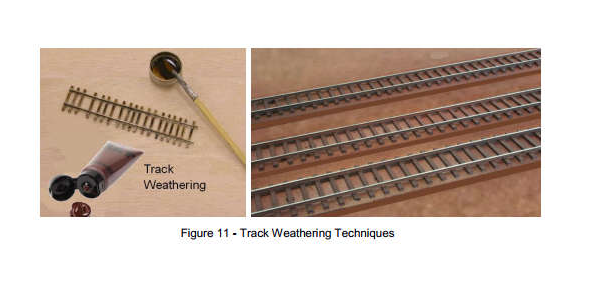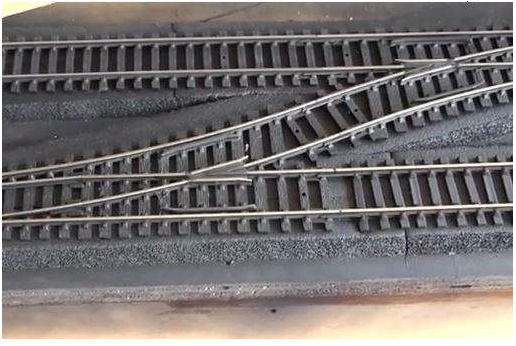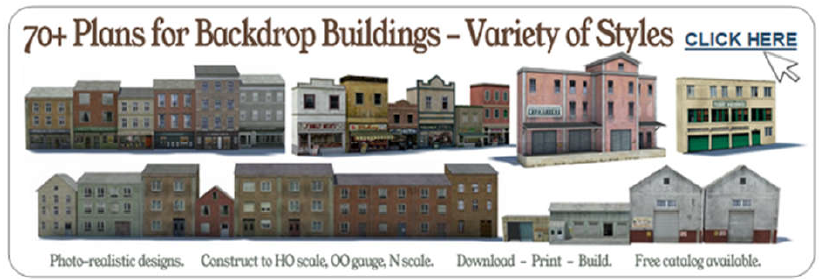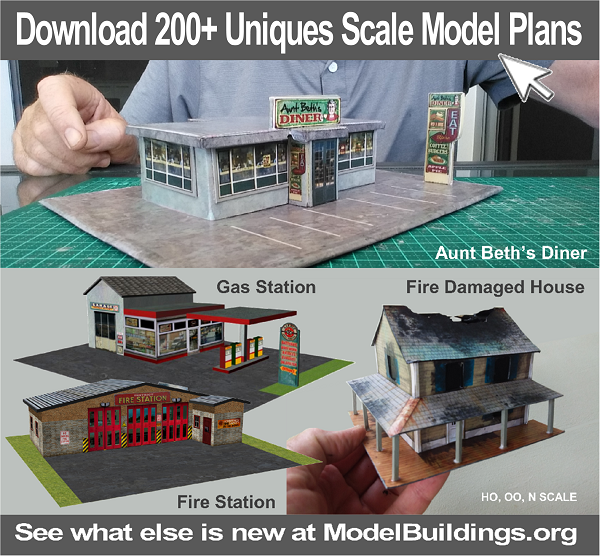Make it Real and Your Model Railroad Will Amaze Visitors To Your Layout
One of the problems with most stock model railroad track is realism. HO and N-scale track in the larger codes is nickel-silver in color and shiny with black ties. Some codes from some manufacturers are available in brown with brown ties as well. However, a trip to view the rails of a prototype railroad will reveal that rails are not consistently colored along their length. There are less-used sections that show more rust, mainline trackage might show a high polish on the rail tops but rusty sides, and different weight rails in sidings and yards will have a different appearance. Where there is locomotive and rolling stock servicing going on, there is likely to be a large amount of oil and grease on the ties between the rails.
© Copyright http://www.modelbuildings.org All rights reserved.
If you want real accuracy in your scenery, you need to treat your tracks and turnouts the same way you would when you carefully weather or detail a locomotive or building. Spend a few minutes browsing Google searches of “railroad track” to get a feel for how it appears in real life, then take a small section of track – a couple of feet – to your workbench and try some techniques to make it look realistic.
One area in which the hand laid track aficionados shine is the alignment of the right of way.


Prototype railroads spend a lot of money to make sure the grade and gauge of all the rail they employ is consistent. However, nature isn’t quite so precise and it’s easy to find sections of track where the rail isn’t arrow-straight or level, and ties are more widely spaced and less uniformly shaped. Exceptional pains are taken to insure that high speed mainlines are straight and level, but sidings and low-speed yard sections are not so carefully controlled and built. You might want to spend a few nights learning how to hand lay rails in order to make your small sidings more realistic while still maintaining the precision and alignment of flex or sectional track on your main lines.
When you are installing and weathering turnouts, going for accuracy must take a back seat to reliable operation. That means that you can’t spray weathering paint willy-nilly around entire turnout. The switch points MUST be allowed to make good electrical contact with the stock rails, and the pivot points must be able to move freely with no binding or sticking. Keep paint OUT of those locations, and if you accidentally hit them with the weathering, go back and carefully remove it with some fine grit sandpaper or emery cloth. Also, since turnouts are all potential derailment locations, make sure that the transition from line to turnout lead has no gaps or rail height disparities.
The same cautions apply to ballast. Most rail modelers use a white glue mixture to retain ballast, which can easily get between the turnout points and stock rails, or get in the way of moving the points at the pivot points. Be very careful to place the track ballast in such a way that it causes no interference to the turnout operation before soaking it with adhesive. One other area to watch for, as it is in mainline track, be sure that the ballast lies completely between the ties and does not cover them. This will prevent trains and rolling stock detail or trucks from catching on high ballast spots.
The Finishing Touches Could Make or Break The Overall Impression
Realism. It’s what we pay for, and what really guides us in the hobby. Some modelers chose a scale based on how much realism can be conveniently created. There are a lot of modelers in this hobby who spend many hours super-detailing locomotives and other rolling stock to make absolutely sure that this car’s brake lines or that locomotive’s custom modifications match the original exactly. You have exactly that opportunity with your turnouts as well. Small roads and older sections of main line still feature manual switch throw stands. Even if you remotely control your turnouts, don’t forget to include a model of such a stand if the era and use suggests its presence.
Line buildings are often found near switches, as they contain the electronics and signaling necessary to operate switches remotely via the CTC network. Signaling stands are also common where passing sidings or diverging routes might contain parked or idling trains.
It’s not uncommon to find discarded sections of rail and old ties lying next to a switch location awaiting retrieval by a maintenance crew. In the steam era, speeder storage huts were a common sight at junction points where routes diverged. Poorly maintained right of way might have growths of vegetation between and alongside the rails, as well as oil stains and discolored ties between the rails. Remember the clearance advice, though. Leave a generous amount of space for those rolling stock overhangs when placing trackside features.


